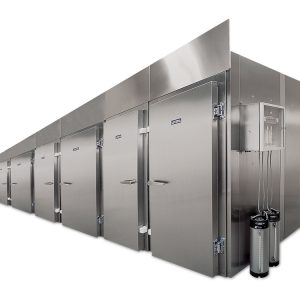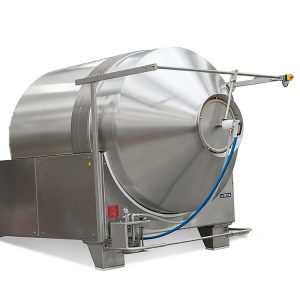The global frozen meat market size is projected to reach over $22 billion (US) in 2021 and grow to over $33 billion (US) by 2026. Frozen meat helps with inventory management related to seasonal demand, extends shelf life for advanced purchasing and long-term storage, and is critical to processors who depend on imported meat for further processing. Now, more than ever, processors are seeking better defrosting methods for their products to increase productivity, reduce loss, and further improve product quality and food safety in the process.
A defrosting system should be fast, productive, versatile, economical and clean. Thawing must be fast in order to prevent the pathogens from coming out of their lag phase. Poorly controlled defrosting reduces the yield and the technological and nutritional qualities as well. Defrosting can be accelerated by reducing the thickness of the product to be thawed, increasing the convective exchange coefficient between the product and the heat transfer fluid, and increasing the temperature of the heat transfer fluid as much as possible, but avoiding conditions that could adversely affect the quality and hygiene of the product. Several thawing methods are available on an industrial scale.
In this article, we will be examining the challenges for defrosting, common methods and advantages.
Challenges for defrosting
Processors are turning to defrosting methods to allow total control of food quality and safety. It is important to first understand the challenges of defrosting and what can be done to overcome those challenges.
Micro-economic issues
Above all, achieving rationalization of production (e.g. according to seasonality) and flexibility of work depending on orders (e.g. speed / just-in-time flow) is very important. Also, it is necessary to optimize industrial productivity (efficiency, speed, reduction of footprint and maximum versatility) and to reduce costs (energy consumption and water consumption), which is also a major environmental issue.
Food safety issues
During thawing, bacteria pass from their latency phase during which their metabolism recovers. At the end of this lag phase, bacterial development resumes. Thus, at 4 ° C under aerobic conditions, the lag phase of Listeria monocytogenes lasts around 3 days, knowing that research has shown that the lag phase of Listeria monocytogenes is even shorter in the case of thawing.
Quality issues
During freezing, ice crystals form in the membranes, which results in losses during defrosting, consisting of:
- Water (water holding capacity is lowered)
- Molecules of technological or nutritional interest
Common Methods for Defrosting
Below is a chart showing the most common methods for defrosting.

Defrosting Advantages
When considering your defrosting methods, Provisur recommends defrosting by steam-vacuum in a tumbler or cold convection using a chamber. Either option can help boost yields but there are differences between Lutetia Industrial Defrosting Equipment that may make more sense for your business.
Steam-vacuum dynamic defrosting in a tumbler is a process patented by Lutetia and intended for all non-fragile food products. Thawing is obtained using the Lutetia Defrosting Vacuum Tumblers by condensing the steam on the product at reduced pressure to prevent surface cooking. This rapid method significantly reduces losses and even incorporates condensates into the product. The upstream use of a block breaker reduces the size of the pieces, which speeds up the process and makes it more homogeneous. The use of a double jacket allows all or part of the heat to be supplied by conduction in order to reduce the reincorporation of condensates. Finally, the ability to combine multiple operations in the same equipment increases productivity.
The main advantages of the steam-vacuum defrosting system are:
Technological quality: Protein losses in defrosting purge are low, or even zero. In all cases, if there is any defrost juice left (i.e. vacuum-packed blocks), it is fully recoverable, for example for use in brine. In addition, the color of the meat is maintained.
Speed: As a consequence of the direct condensation of the steam on the product combined with the rotation of the tank – this process is very fast, up to 4 to 8 times shorter than conventional methods.
Consistency: Fine temperature control ensures constant cycle times. The radio or infrared transmission probe systems allow continuous product temperature monitoring. Likewise, weight monitoring using a weighing scale system makes it possible to control the amount of steam injected.
Food safety: On the one hand, the product remains confined under vacuum, sheltered from the development of spoilage aerobic flora, and on the other hand, since the process lasts less than 15 hours, the surface of the product remains for a short time between -2° C and + 4° C, which limits bacterial awakening. Finally, each cycle can be associated with a batch number of material in the supervision software, to benefit from full process traceability with recording.
Productivity: This process makes it possible to carry out a combination of operations (defrosting, salting, cooking, and cooling) in a single machine. The equipment also takes up a small footprint.
Cost-effective: Yield gains are significant and the product retains its moisture and proteins. The steam injected under vacuum is retained in the case of certain meats, especially if it is possible to add a little salt.
Cleanliness: With reduction of effluents and their organic load, the product retains its water and proteins and most often absorbs all or part of the steam.
Defrosting in chamber is particularly recommended for fragile products, making the Lutetia Defrosting Chamber is ideal because it respects even the most delicate foods. Its speed relies on maximizing the transfer conditions at the frozen product interface, which is ventilated at high velocity by temperature-controlled steam carrier air as well as water mist. The product surface is never dry and thawing losses are reduced. Using a mist from cooled water helps maintain a cool surface temperature until defrosting is complete.
The main advantages of the cold convection defrosting system are:
Speed: The optimization of heat transfers inherent in the system enables defrosting times to be reduced by a factor of 2 to 4 compared to thawing in the open air.
Versatility: The defrosting chamber adapts to all product categories (meat, fish, vegetables, fruits, cheeses, etc.) in any form (blocks, buckets, trays, bags).
Consistency: By continuously monitoring ambient and core temperatures and by the aeraulics design, the defrosting times are fixed.
Food safety: The individualized arrangement of the material to be defrosted on the trolley avoids any risk of cross contamination. Defrosting times are short enough for bacteria to remain in the lag phase.
Hygiene: By implementing a double temperature control system at the core and at the surface, the defrosting conditions are optimal from a hygienic point of view.
Technological quality: This process is particularly respectful of the fragile products integrity, insofar as the products remain static and can even be defrosted in bags or pockets.
Application Example (Tumbler)
Defrosting in a tumbler is often implemented in the field of meat and seafood. Steam is injected under reduced pressure to condense at low temperature without cooking the surface of the product and maintaining the transfer of latent heat of condensation from the steam to the product.
When defrosting in a tumbler, the vacuum in the tumbler should be maintained at a suitable value. It is therefore advisable to stay below the temperature at which the fibrillar proteins start to coagulate.
The first principle of defrosting in a tumbler is to carry out an initial vacuuming of the tank. The second principle consists in subsequently alternating the following sequences:
(1) A steam injection phase
(2) A pause phase to let the steam condensate
(3) A vacuum recovery phase
The third principle of defrosting in a tumbler, which applies to blocks, is to reduce the injection of steam as it is defrosted while accelerating the rotations. In fact, at the start of defrosting, if the blocks which are still frozen and hard fall on the first thawed products, the structure of the meat is damaged. A final temperature balancing phase by tumbling with a double jacket supplied with cold glycol is also recommended.
A tumbler defrosting program involves injecting a given weight of steam into the tank over a given time. For a 500 kg batch, the program will therefore be different from that of a 1000 kg batch.
Controlling the weight of steam injected requires good control of the steam flow rate of the steam generator used.
The quality of defrosting is the result of the steam condensing directly on the food. Also, it is essential to check that the vapor which condenses. Whatever the use of single or double jacket tumbler, steam acts similarly on the products and only the level of steam could be adjusted.
Lutetia Defrosting
Lutetia, was acquired by Provisur Technologies in 2017, but the company has been producing innovative solutions since its inception in 1965. Lutetia develops technologies for Defrosting, Marinating and Cooking and holds a wide range of patents for being the first and only manufacturer with these yield boosting technologies. Our application enterprise sets us apart from the competition, working with customers throughout the world to solve their processing challenges or application innovations.
We hope you found the information in this article insightful. Provisur is here to help with all of your processing needs.
Contact here to learn more.


